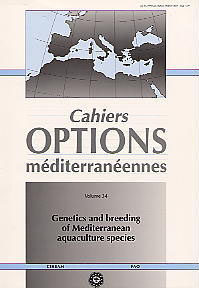| Article précédent | p. 265-272 | Article suivant |
Microsatellite polymorphisms in wild populations of European seabass: Preliminary results
Studies on population genetics of the European seabass (Dicentrarchus labrax) have shown the existence of extensive allozyme variation particularly between populations in different sea basins. The migration behaviour of juvenile and adult bass and the low levels of differentiation observed between samples in the same hydrographic area have lead to the assumption of a panmixia over quite large areas of the species range. Recently more detailed studies using allozymes, mtDNA and microsatellites and more powerful statistical methods are shedding new light on the population structure of this species. Microsatellites, in particular, because of their high levels of polymorphism, are powerful markers for revealing population structuring. Five microsatellite loci were screened in over 300 individuals from 5 wild Portuguese populations. Preliminary results indicate high levels of polymorphism among the loci screened and the multilocus tests indicate the existence of population structuring at a small geographic scale.
- [ Télécharger ]
- [ Exporter la citation ]
Vous pouvez télécharger la citation au format :
- [ Imprimer ]
- [OMC34]




